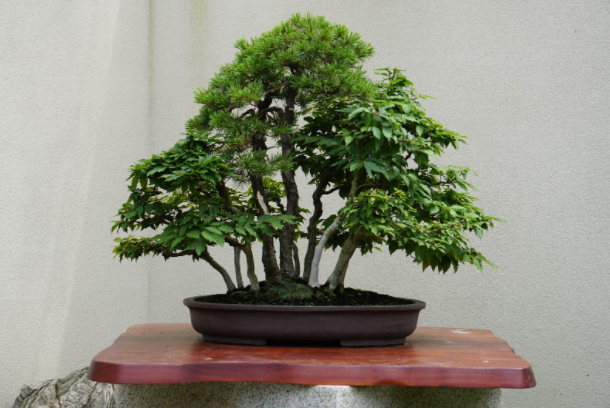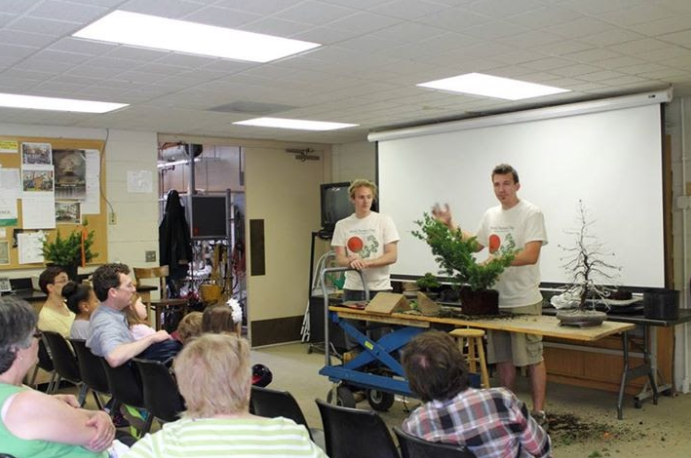All photo credit: Bill Valavanis
Summer 2020 is officially the summer of the bonsai blog series! We’re launching another string of blogs to highlight the fascinating history and teachings of some of the most influential bonsai masters. For our first edition, we spoke with Bill Valavanis, a National Bonsai Foundation director and bonsai artist, about his time training under Yuji Yoshimura.
Valavanis dubs Yoshimura his “Japanese father” from whom he learned on the weekends while studying horticulture during college in the 1960s. He said Yoshimura felt like a god to him when they first met, as Yoshimura’s book The Japanese Art of Miniature Trees and Landscapes – later reprinted as The Art of Bonsai: Creation, Care and Enjoyment – is considered a “bonsai bible.” The book is the first authoritative source for bonsai artists written in English.
Yoshimura began his bonsai work under his father’s tutelage. He and Alfred Koehn, a notable authority on Japanese art, organized and produced the first beginner’s bonsai course at Yoshimura’s family nursery in Tokyo in 1952.
The first bonsai instructional class in 1952.
Yoshimura’s father, who rekindled the craft of classical bonsai, was the most influential person in his bonsai career. Valavanis said Yoshimura’s family remained anchored in Japan, but he wanted to spread the art of bonsai around the world. He traveled to Australia, Hong Kong, England and across the United States, where he and his family lived for many years.
But Yoshimura sacrificed the stability of his relationships when he left home. One of his younger brothers took over his garden after he left, Yoshimura’s wife and one daughter eventually moved back to Tokyo and Yuji was highly criticized in Japan for teaching the “Yanks” in America – but Yoshimura loved the United States.
“He found Americans very friendly,” he said. “He went through a lot of students but he would take care of them, tell them extra things, treat them nicely and encourage them.”
Yoshimura’s daughters and granddaughter with the U.S. National Arboretum director.
Yoshimura took Valavanis to Japan to meet other influential bonsai figures. Upon returning to the United States, Valavanis lived with him for almost a year to study the classical Japanese style of bonsai. He said Yoshimura would personally demonstrate wiring or care techniques, unlike many current apprentices learning bonsai in Japan, who are often left to grasp concepts by themselves.
“He taught me the basics and introduced me to the Japanese fine quality classic bonsai,” Valavanis said. “He showed me where I can improve, get more information and how to study.”
Former U.S. National Arboretum director John Creech and Yoshimura in 1973.
Yoshimura relied on old, historic books – some of which he took from his father in Japan – for bonsai knowledge and left Valavanis his library when he retired. He is known for his strict teaching style, adhering to traditional Japanese designs – his father’s influence – and curt lessons.
“Once when I was cleaning the kitchen floor, I put back our two chairs and went out to do something, but my chair was missing when I came back,” Valavanis said. “I put it back two or three times, but finally I got the hint time for me to leave.”
Yoshimura attending a bonsai convention.
Even after the two parted as roommates, Yoshimura routinely visited Valavanis’ garden, helped him establish a bonsai magazine and remained a teacher and friend until he died in 1997.
Valavanis said the most important takeaway from Yoshimura’s teachings is to do what he thinks is right and avoid too much influence from other artists. He took that advice with him to start the first American bonsai exhibition, the highest level show in the United States, which is now in its seventh year.
“He told me to stand on his head or shoulders to take the art higher,” Valavanis said. “He wanted me to use what he had and go improve.”
For more on Yuji Yoshimura, you can head to Valavanis’ blog posts here and here. If you have any personal stories or memories with Yoshimura, tag us in them on social media: Instagram, Facebook and Twitter.




























